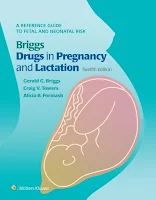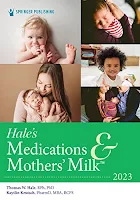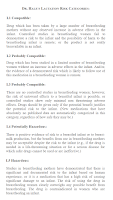Drugs and Lactation
Introduction
Apart from drug safety in pregnancy, ensuring the safety of medications during breastfeeding is another important consideration. We are particularly concern about how much drugs are being passed onto the baby through breast milk. If it does, is there any concern on adverse effects?
- Nearly all drugs transfer into breast milk to some extent. Notable exceptions are heparin and insulin which are too large to cross biological membranes.
- As a general rule, breastfeeding is considered acceptable when the relative infant dose is <10%.
In the past, package inserts were not always reliable sources of information regarding medication safety during lactation.
- However, the FDA published the Pregnancy and Lactation Labelling Rule (PLLR) on 3 December 2014, which requires data on medication transfer into breast milk to be included in the product inserts of prescription drug and biologic product applications submitted after 30 June 2015, while labelling for prescription drugs approved on or after 30 June 2001, will be phased in gradually.
Apart from standard references such as Australian Medicines Handbook, British National Formulary and Lexicomp, several important references to assess the safety of medications in lactation are
- LactMed
- Briggs' Drug in Pregnancy and Lactation
- Hale's Medications & Mothers' Milk
- MotherToBaby
NOTE: The necessity of medication should always be the first question. If yes, is there a preferred alternative?
LactMed
LactMed is part of the US National Library of Medicine's (NLM) Toxicology Data Network (TOXNET). If focuses on safety of drugs and other chemicals that breastfeeding mothers may be exposed to.
- LactMed provides information on substance levels in breast milk and infant blood, as well as possible adverse effects on nursing infants.
- It also suggests therapeutic alternatives where appropriate.
LactMed apps for Android and iOS devices were retired on 16 December 2019.
- Current users of the LactMed apps are encouraged to continue accessing LactMed via Bookshelf.
- Recognizing the need for a dedicated mobile solution, MotherToBaby launched LactRx in 2022, in collaboration with the National Library of Medicine. This free app offers convenient access to the National Library of Medicine's LactMed database, expanding its accessibility.
Briggs' Drugs in Pregnancy and Lactation
Drugs in Pregnancy and Lactation contains detailed monographs on over 1400 commonly prescribed drugs used during pregnancy and lactation.
- The monographs provide information on known or possible effects on the mother, embryo, foetus, and nursing infant.
This book received highly recommended recognition in Obstetrics and Gynaecology at the British Medical Association (BMA) Medical Book Awards in 2018 and selected as a Doody's Core Title for 2022 and 2023.
Hale's Medications & Mothers' Milk
Hale's Medications & Mothers' Milk is published biannually and includes a scoring system that makes it easy to assess a medication at first glance.
- The monographs also include text describing available data, paediatric concerns and alternative medications.
- Mobile app is available: iOS and Google Play.
MotherToBaby
The Organization of Teratology Information Specialists provides information (in English and Spanish) for women and healthcare providers on the risks and safety of taking medication during pregnancy and breastfeeding.
- Website: https://mothertobaby.org/
Summary
In a 2007 study comparing safety in lactation information provided by 10 different references for 14 commonly used medications, significant variation was found between resources, even for medications well established as safe for breastfeeding.
- Therefore, it is recommended to consult reliable and up-to-date resources and cross-reference information from multiple sources to ensure consistency.
External Links
- e-lactania
- InfantRisk Center
- MIMS Guide to Drugs in Lactation
- Pregnancy and Breastfeeding Medicines Guide
- Breastfeeding Your Little One
- Lactation safety recommendations and reliability compared in 10 medication resources, 2007
- Evaluating Medication Use in Pregnancy and Lactation: What Every Pharmacist Should Know, 2013
- OTC Medication Use in Pregnancy and Breastfeeding, 2019
- Breastfeeding and Medication Safety, 2022






Comments
Post a Comment